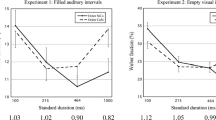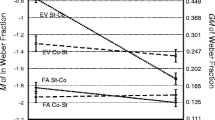Summary
One hundred and sixty subjects judged the duration of short lights and sounds along 9-category response scales with no drug, a placebo, 200 mg secobarbital, or 15 mg dextroamphetamine. Measures of average category response and intrasubject response variability were obtained from single stimuli judgments of blocks of alternately presented auditory and visual signals using two temporal standards (i.e., social and subjective) 30, 60, and 90 min post-drug. The experiment produced main effects of and interactions among six factors: 1. Four drug conditions; 2. two sense modes; 3. two sense mode orders; 4. two temporal standards; 5. seven durations; 6. three post-drug trials.
Dextroamphetamine yielded longer judgments or overestimation relative to control conditions at 30 min which persisted to 60 and 90 min; secobarbital produced shorter judgments or underestimation at 60 and 90 min. The stimulant effect was more rapid and greater the sedative effect in shifting the location of temporal scales, and these results were independent of sense mode, order and temporal standard.
While the placebo and dextroamphetamine subjects were more variable than controls, this effect was greatest with secobarbital suggesting reduced consistency as the prime sedative effect.
Similar content being viewed by others
References
Frankenhaeuser, M.: Estimation of time. Stockholm: Almqvist and Wiksell 1959.
Goldstone, S.: The human clock: A framework for the study of healthy and deviant time perception. In Interdisciplinary perspectives of time (Eds., R. Fisher and A. Sollenberger). Trans. N. Y. Acad. Sci. 138, 768–783 (1967).
—, W. K. Boardman, and W. T. Lhamon: Effect of quinal barbitone, dextroamphetamine, and placebo on apparent time. Brit. J. Psychol. 49, 324–328 (1958).
—, and J. L. Goldfarb: Auditory and visual time judgment. J. gen. Psychol. 70, 369–378 (1964).
— —: The perception of time by children. In the development of perception in children. (Eds. A. H. Kidd, and J. L. Rivoire) pp. 445–486. New York: Internat. Univ. Press 1966.
Hormia, A.: On the sensation of duration. Ann. Acad. Sci. fenn. 58, 1–81 (1956).
Lhamon, W. T., S. Goldstone, and J. L. Goldfarb: The psychopathology of time judgment. In The psychopathology of perception (Eds., P. Hoch, and J. Zubin) pp. 164–188. New York: Grune and Stratton 1965.
Webster, F. R., S. Goldstone, and W. W. Webb: Time judgment and schizophrenia; psychophysical method as a relevant contextual factor. J. Psychol. 54, 159–164 (1962).
Author information
Authors and Affiliations
Rights and permissions
About this article
Cite this article
Goldstone, S., Kirkham, J.E. The effects of secobarbital and dextroamphetamine upon time judgment: intersensory factors. Psychopharmacologia 13, 65–73 (1968). https://doi.org/10.1007/BF00401619
Received:
Revised:
Issue Date:
DOI: https://doi.org/10.1007/BF00401619




